Post Thirteen - Voyage to Australia
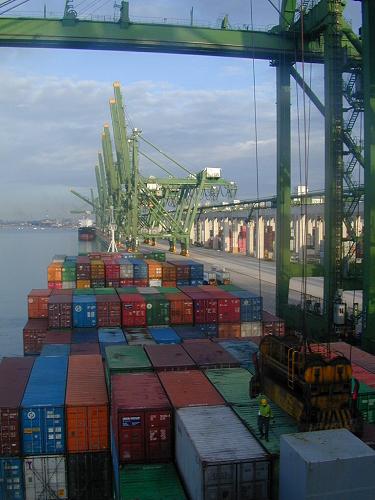 Singapore Dockyards Singapore Dockyards50 years ago, most travel between Europe, Asia and Australia involved long and sometimes hazardous journeys by sea. Today I can board a plane in L.A. and get anywhere in the world within 12 hours. On this trip I wanted to go around the world while getting a sense of how big it actually is. The only way to do this is to stick to ground transportation. Going from Singapore to Australia, therefore, means going by ship. Karen really doesn't like to be on the open ocean, so she said she would fly on ahead and wait for me in Brisbane. While we were in Sevilla, I discovered Christina Horn and Internaves Freighter Travel. Her company sells space for passengers on freighters all over the world. I told her my plans and she found me passage on a German ship traveling from Singapore to Brisbane, Australia. I booked it, and three months later, I was at the port facilities in Singapore looking for the MS Buxcrown. The port in Singapore is supposedly one of the largest in the world. Luckily the ship's agent took me though immigration and out to my waiting vessel. The captain got me situated in my cabin and I went out on deck to watch the ship being loaded. The cranes in this photo are bigger then they look. They quickly move the 20 and 40-foot containers and stack them in the hold like Lego's. Our ship could carry 1,800 20-foot containers (or TUs as they are called). |
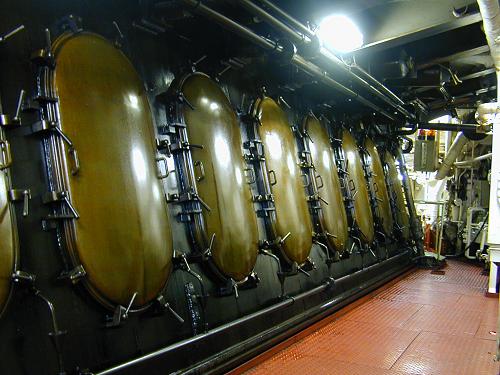 Engine Room Engine RoomThe first thing I did aboard once we were at sea was to have a good look around the ship. During my career as an oceanographer, I've probably spent a total of eight months at sea. This ship was different than the research vessels I've been aboard. For one, all the living space is crammed into several small decks on the stern end of the ship behind the cargo. My stateroom was on deck seven so I had a nice view out the portholes of the ocean. Like other ships I've been on, there are separate dining areas for the officers and the crew. I ate with the officers. This was a German ship with German officers so the food was mostly meat and potatoes. The crew was Filipino, and they had their own food. Most Western-operated freighters have Western officers and Asian crews. The Asians are great sailors and much cheaper to hire than Westerners. I'm always interested in things mechanical so one day the chief engineer showed me around the engine room. This is a photo of the transmission linkage. I can't imagine spending months working down there. It was hot, smelled of diesel and oil, and the noise was deafening (we wore ear protection). |
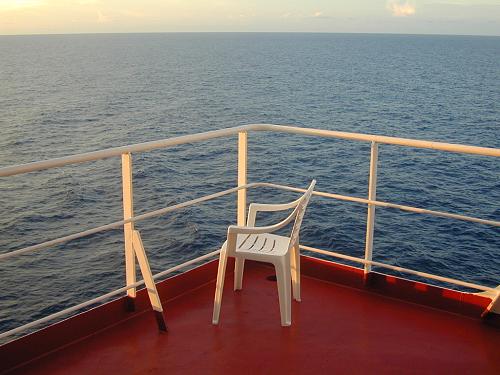 Spare Time Spare TimeUnlike the officers and crew, I had no duties aboard besides attending the weekly lifeboat drill. I had plenty of books and a laptop full of photos that needed processing so I kept busy. Still, life at sea can get monotonous. Unless there is a storm or you are going into port, every day is the same. On this ship there were only two other passengers - an older couple that I saw rarely - so outside mealtimes I was mostly alone. Below is a typical day at sea for me on this trip: |
| Wake up and have a shower. | |
| Breakfast - usually cereal, toast and coffee. Eggs and bacon if I'm especially hungry. | |
| Finish coffee and chat up the captain and other passengers. | |
| Work on a crossword puzzle (on deck if it's nice out). | |
| Work on the computer (organizing photos, writing, etc.) | |
| Lunch - the biggest meal of the day. Some type of meat and potatoes with soup and perhaps a salad. Wine served on Sunday. | |
| Reading on deck. | |
| 2 - 4 pm | Work on the computer (and use the Encarta Desk Reference to finish my crossword). |
| 4 - 6 pm | Walking around deck, having a cup of tea, watching the sunset, visiting the bridge, chatting with the captain, staring at the water, etc. |
| 6 - 7 pm | Dinner - German style, lighter, meats and cheeses with bread, canned fish, salad. |
| 7 - 9 pm | Reading, work on the computer. Have a beer (alcohol available for purchase onboard at duty free prices). |
| 9 - 11 pm | See what movie is playing in the lounge. The officers watch movies in German but the crew has movies mostly in English. |
| 11 pm | I stop at the bridge to chat with the second officer, see the chart of our course, read the weather and news fax from the WeatherSat, look at the stars, and then it's off to bed. Another busy day at sea. |
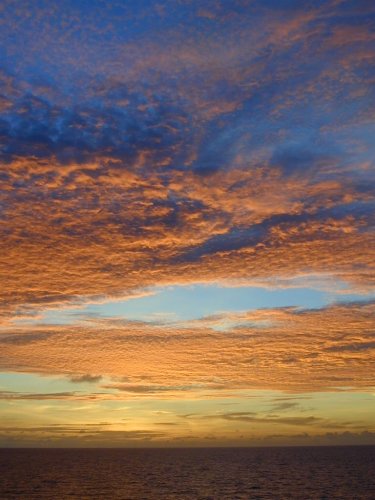 Solitary Sunset Solitary SunsetProbably my favorite things at sea are the sunsets, sunrises, and the stars at night. Away from land, with a limitless horizon these sights can be spectacular. At sea, you have a lot of time to yourself. Watching a beautiful sunset in the middle of the ocean is lonely yet all the more beautiful because you are the only one to see it. It's also affirming in a way because of the self-reliance you learn to develop when you are by yourself. It always takes me a while to get used to shore life when I come back from being at sea. It's a bit hard to explain but any sailor will know what I am talking about (Craig, Todd, Mel?). |
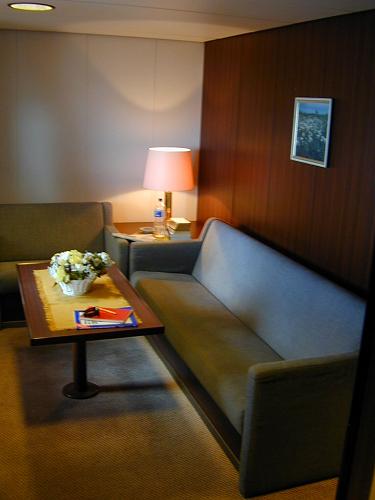 My Salon My SalonThis is a view of the living area (or salon) in my stateroom. It had a couch, desk, chair, and two portholes. There was also a head (bathroom) with a shower and toilet. I spent much of my time here when it was too windy on deck or when I was working on the computer. |
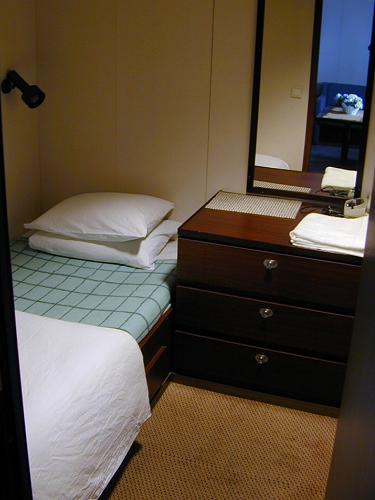 My Bunk My BunkThis is a view of my bedroom with my bunk (taken 180 degrees from the previous photo). I had a closet (with my life preserver in it), dresser, and a lamp by the bed. There was a door but no windows. This is common on ships since people work in shifts 24 hours a day. Those people with the night shift want somewhere dark to sleep during the day. One thing about ships, though, is everything seems to rattle and creak while we are underway. I ended up shoving wads of toilet paper in all the cracks in the wall panels and and dresser drawers in an attempt to quiet things down a bit. |
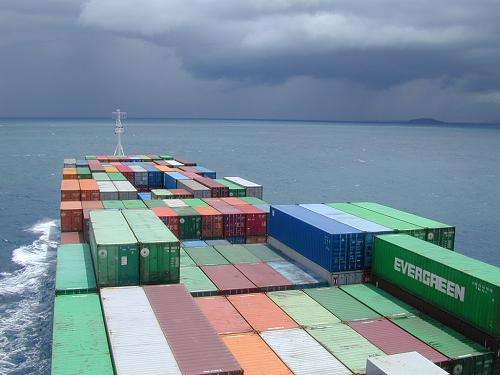 Foul Weather Foul WeatherTraveling by freighter is not for everyone. It can get quite boring except when there is a major storm or something (then it's exciting in a way not everyone would appreciate). Yes, I do get seasick if the swells are strong, but these ships are very large and most of the time you don't even feel the movement. Going by ship is always more expensive than flying (unless you fly first class), and the days when you could work for your passage are long over. The food is not great and you spend most of your time alone. |
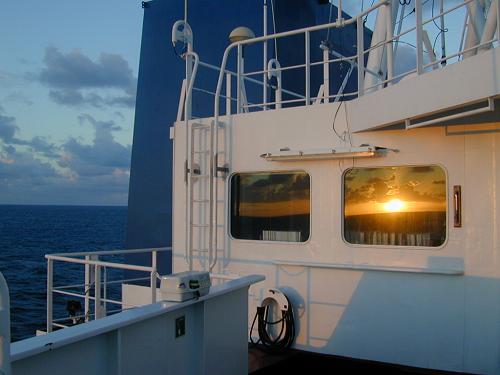 Fair Skies Fair SkiesDespite the above caveats, a sea journey brings it's own rewards that are hard to obtain on land. In good weather you will see sunsets that bring tears to your eyes and nights where you are wrapped in a canopy of stars. In foul weather you'll witness a force of nature unlike anything you've seen before and you will begin to understand the achievements of the early explorers. But mostly, at sea you will come to know yourself very well. |
Next Up: Welcome to Oz
Copyright 2002
Scott & Karen Semyan